HGST Deskstar NAS 4 TB Review
by Ganesh T S on November 22, 2014 2:00 PM ESTRAID-5 Benchmarking - Miscellaneous Aspects
Consumers are rightly worried about RAID rebuilds and the scope for drive failures during that process. As one of our evaluation aspects, we randomly yanked out a disk during operation and cleaned it up for rebuild. We recorded the resync duration (time taken to rebuild a 3-disk RAID-5 volume when one of the disks needs to be replaced) as well as the average power consumption during that process. The two aspects, considered together, give an idea of the efficiency of the hard drive. The graph below presents the total energy consumption (Resync Power Consumption (W) X Resync Duration (s)) for the resync.
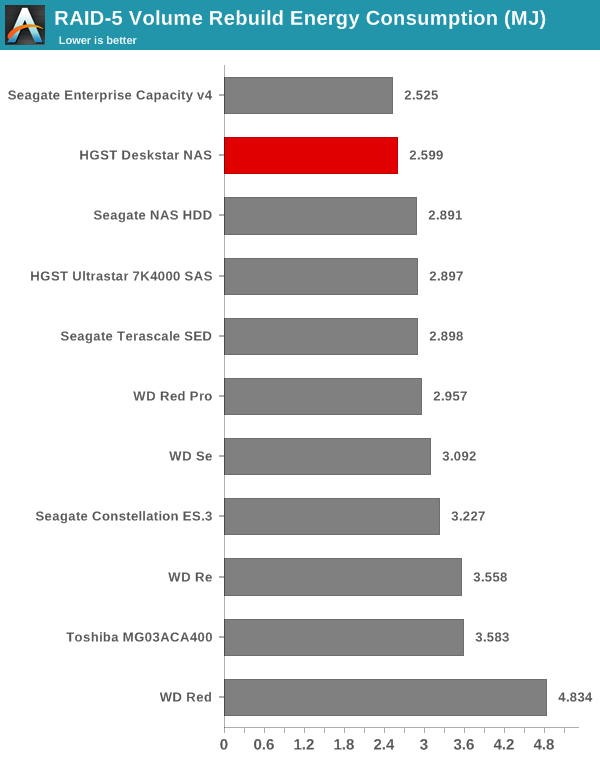
While the energy consumption aspect provides a consolidated view of the various factors, it is still worthwhile to look at the power consumption and resync duration numbers separately. The table below provides the raw information behind the above graph. The HGST Deskstar NAS is not the most power efficient, but makes up for the higher power consumption by getting the job done much faster than the drives with better power numbers.
| RAID-5 Resync Power Consumption & Duration | ||
| Drive | Power (W) | Duration (s) |
| HGST Deskstar NAS | 100.25 | 25922 |
| WD Red | 87.7 | 55125 |
| WD Red Pro | 102.72 | 28787 |
| Toshiba MG03ACA400 | 99.84 | 35886 |
| WD Se | 102.07 | 30293 |
| Seagate Enterprise Capacity v4 | 98.38 | 25670 |
| Seagate NAS HDD | 92.82 | 31149 |
| Seagate Terascale SED | 92.8 | 31230 |
| WD Re | 102.09 | 34850 |
| Seagate Constellation ES.3 | 102.37 | 31520 |
| HGST Ultrastar 7K4000 SAS | 98.35 | 29456 |
We also measured power consumption during the last stage of our multi-client test. With 25 different clients simultaneously stressing the NAS with different types of workloads, we recorded the power consumption at the wall for the NAS as a whole. The various numbers are presented in the graphs below.
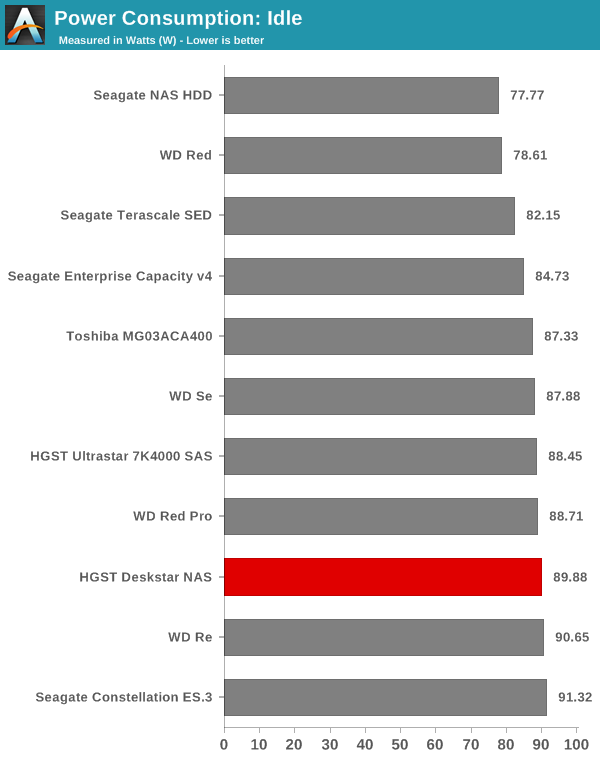
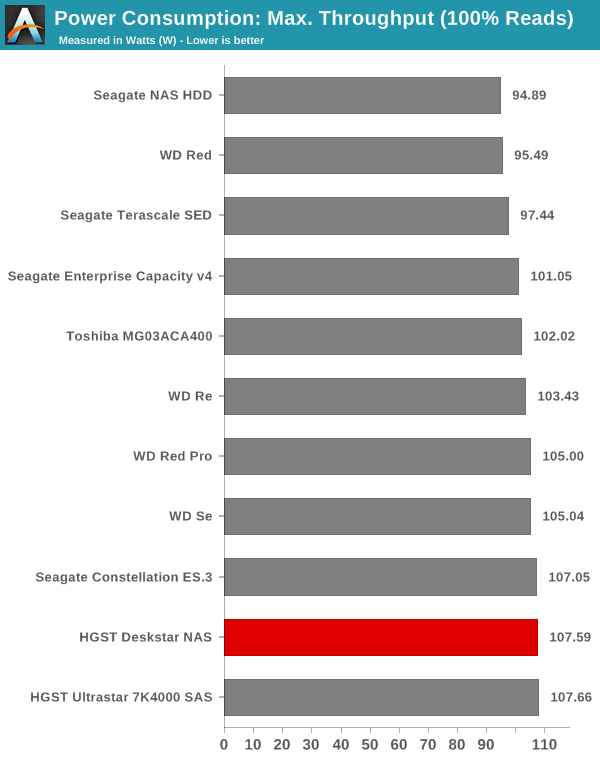
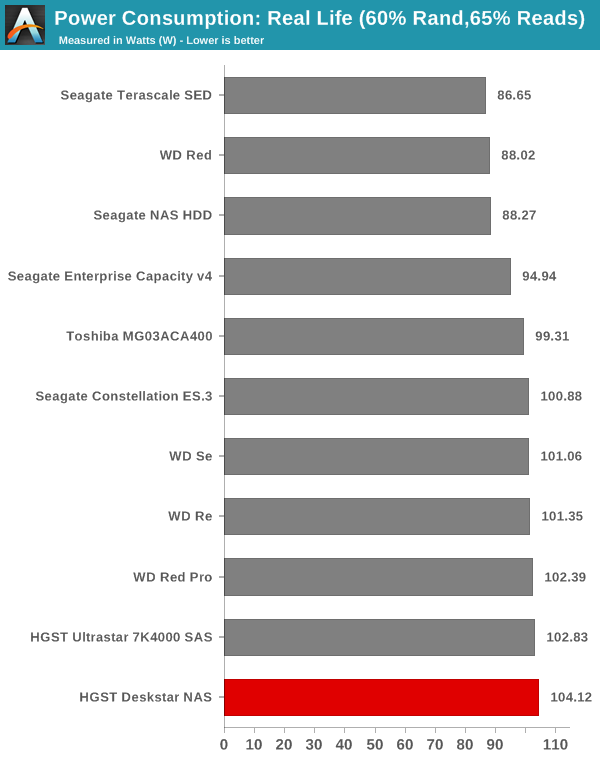
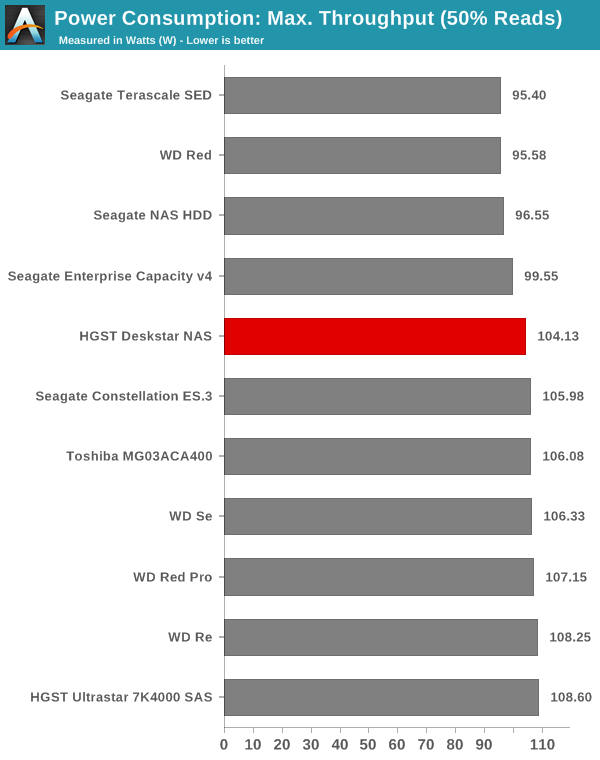
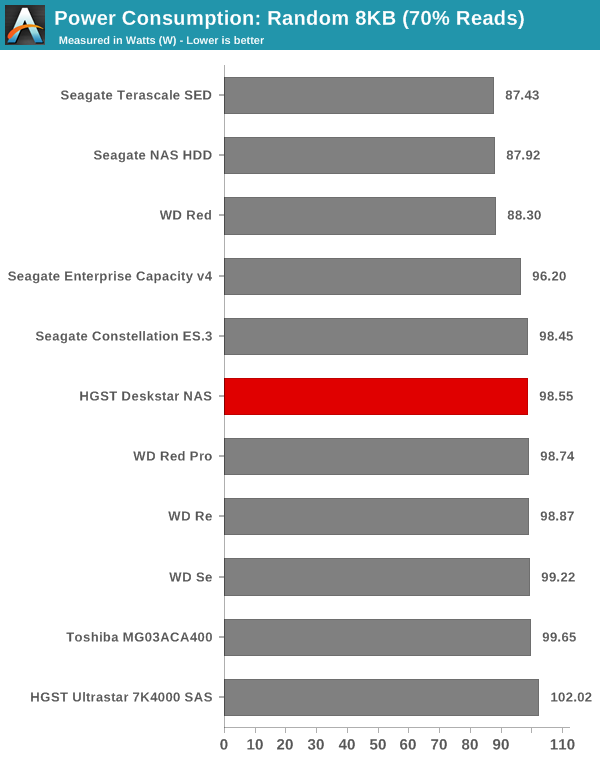
As expected, the units providing better performance have higher power consumption numbers. The HGST Deskstar NAS could be a bit more power efficient, particularly since units such as the Seagate Enterprise Capacity v4 manage to deliver similar / better performance with a better power consumption profile.










39 Comments
View All Comments
josue16 - Monday, November 24, 2014 - link
So, which of the 4 TB drives are more reliable? Are there companies that report HDD reliability?jota83 - Monday, November 24, 2014 - link
Not really.... just MTBF and unrecoverable errors rate. The one that is collecting data since its foundation is, as stated multiple times along the comments, backblaze. They are collecting a lot of data and reporting those to the community in a periodic basis. They have surveyed several branched, and they have a pool of more than 30k disks and growing. Even if they are a very respectable firm, their strategy to offer unlimited backup for a very low feed lead them to look for a design that while being robust is very cheap... hence the NAS disks "consumer" grade. I find fascinating what they have achieved in no time! You might want to check at their blog, with plenty of nice information. Cheers!Jeff Biscuits - Tuesday, December 9, 2014 - link
Anyone happen to know when the 5TB and 6TB versions are due to hit UK? They're listed on the HGST website but when I look for them for sale I only find them available on US retailersalecweder - Wednesday, February 4, 2015 - link
The biggest issue with RAID are the unrecoverable read errors.If you loose the drive, the RAID has to read 100% of the remaining drives even if there is no data on portions of the drive. If you get an error on rebuild, the entire array will die.
http://www.enterprisestorageforum.com/storage-mana...
A UER on SATA of 1 in 10^14 bits read means a read failure every 12.5 terabytes. A 500
GB drive has 0.04E14 bits, so in the worst case rebuilding that drive in a five-drive
RAID-5 group means transferring 0.20E14 bits. This means there is a 20% probability
of an unrecoverable error during the rebuild. Enterprise class disks are less prone to this problem:
http://www.lucidti.com/zfs-checksums-add-reliabili...
hansmuff - Thursday, March 5, 2015 - link
You can circumvent these issues by using ZFS. Put that on a box with ECC RAM and back it up online, and you've got a pretty reliable solution.willis936 - Saturday, May 9, 2015 - link
I've done receiver testing on sata drives before and I can tell you while drives are only tested to 10^-14 BER with 95% confidence that if the channel is clean and both the host and hard drive have good phys and you don't do something like put your phone on the hard drive then you won't see a single phy related error until something fails. A URE refers to a drive failure to read a bit. It's unrelated to sata as you implied.comomolo - Tuesday, May 17, 2016 - link
Is it really worth it to get these NAS drives vs their regular versions? My use case is a home NAS, Linux software RAID or ZFS (no HBA). Will I miss anything by not using the NAS version of the drive? The difference in price is not trivial in Spain (some 20% more for the NAS model).Thanks for any help.
Hisated936 - Saturday, June 9, 2018 - link
Comcast won't send you your neglected password https://xfinitylogin.us/ On top of the homepage, you must see the Sign in link, Click it to get redirected.ffarzan - Tuesday, June 29, 2021 - link
I bumped into your web site checking spec. on Hitachi 4TB, and saw your comparison chart , extremely useful,do you have any such comparison table for Seagate, or by Model No. across any given brand, and manufacturer ?? , Thanks